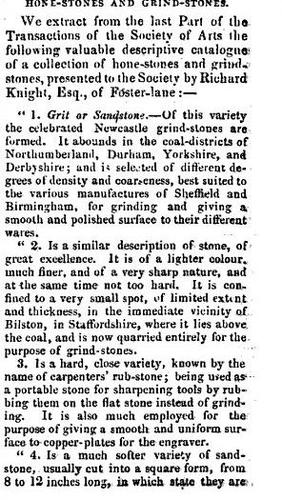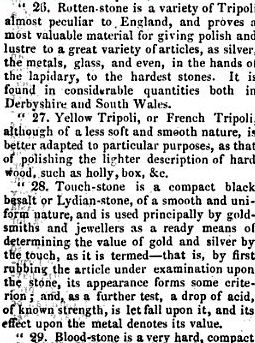Results 1 to 10 of 26
Thread: Hones Description article 1835
-
09-26-2012, 12:37 PM #1Historically Inquisitive



- Join Date
- Aug 2011
- Location
- Upstate New York
- Posts
- 5,782
- Blog Entries
- 1
Thanked: 4249 Hones Description article 1835
Hones Description article 1835
Hones, Stones, Grind-stones article From Museum, Register, Journal, and Gazette 1835. Very interesting description and uses of different hones.








-
The Following 7 Users Say Thank You to Martin103 For This Useful Post:
Bushdoctor (09-26-2012), Firefighter2 (09-26-2012), hoglahoo (09-27-2012), mapleleafalumnus (09-26-2012), MJC (09-26-2012), Steve56 (08-29-2019), Wullie (09-27-2012)
-
09-26-2012, 01:18 PM #2Senior Member


- Join Date
- Jul 2011
- Posts
- 2,110
Thanked: 459
It looks like it was copied right out of holtzappfel volume 3.
-
09-26-2012, 01:24 PM #3

Thank for sharing this info Martin,
also if is curious that at points 15 and 16 are described the belgian coticule caractheristics, but named German water hone.
I think there was a bit of confusion in the past.
-
09-26-2012, 01:24 PM #4Historically Inquisitive



- Join Date
- Aug 2011
- Location
- Upstate New York
- Posts
- 5,782
- Blog Entries
- 1
Thanked: 4249
-
09-26-2012, 01:39 PM #5Senior Member


- Join Date
- Jul 2011
- Posts
- 2,110
Thanked: 459
Perhaps holtzappfel copied it, the descriptions for some things are word for word. Or maybe he provided it, since he was deceased prior to the publication of the first edition of III in 1850.
-
09-26-2012, 01:41 PM #6Senior Member


- Join Date
- Jul 2011
- Posts
- 2,110
Thanked: 459
-
09-26-2012, 01:44 PM #7
-
09-26-2012, 01:54 PM #8Historically Inquisitive



- Join Date
- Aug 2011
- Location
- Upstate New York
- Posts
- 5,782
- Blog Entries
- 1
Thanked: 4249
-
09-26-2012, 01:57 PM #9Senior Member


- Join Date
- Jul 2011
- Posts
- 2,110
Thanked: 459
How many yellow thuringian stones have we ever seen that were glued to blue slate?
Maybe it's a case of the author relying on information from someone else and getting it confused.
-
09-26-2012, 01:59 PM #10


 24Likes
24Likes LinkBack URL
LinkBack URL About LinkBacks
About LinkBacks






 Reply With Quote
Reply With Quote
